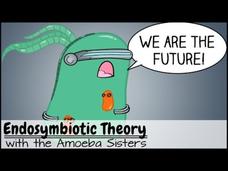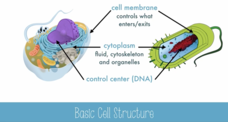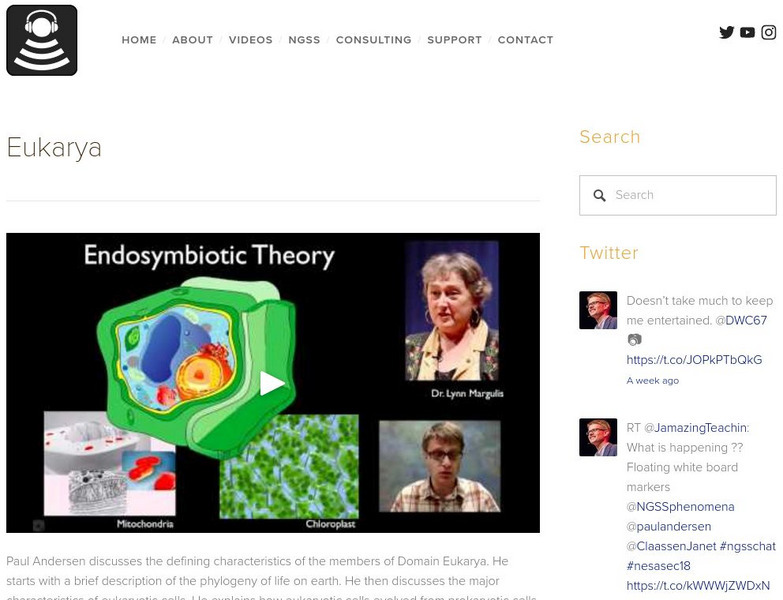Bozeman Science
A Tour of the Cell
Adult humans are made of around 40 trillion cells that can't be seen these without some really powerful microscopes! Learners tour both prokaryotic and eukaryotic cells, learning how their structures are similar and different, and...
Curated OER
A Tour of the Cell
The differences between prokaryotic and eukaryotic cells are explained and the parts of each are highlighted. Discover the major organelles found in an animal cell and each of their functions. Paul Andersen does an excellent job once...
Bite Sci-zed
Mitochondrial DNA
Do young scientists know that some traits are only passed down by the mother? Mitochondrial DNA is an interesting phenomenon that provides researchers with a lot of useful information. Scholars learn about the endosymbiotic theory, what...
Be Smart
The Deadpool Salamander
Much like your favorite superhero, the axolotl has amazing super powers! Explore the extraordinary world of the salamander that never grows up in a video from a larger science playlist. Content includes axolotl behavior versus normal...
Amoeba Sisters
Inside the Cell Membrane
Without the cell membrane, our cells just couldn't keep it together! What else does this multifunctional membrane do? Take a deeper look at the fluid mosaic model using a video from an expansive biology playlist. Topics include embedded...
Amoeba Sisters
Endosymbiotic Theory
Eukaryotes—were we born from an act of predation that backfired? Ponder this and other questions of evolution with a video from a well-written biology playlist. Topics include the origins of mitochondria and chloroplasts, unusual...
Amoeba Sisters
Introduction to Cells: The Grand Cell Tour
Ready to begin cell biology in a grand fashion? Start the adventure using a short but thorough video from a vast biology playlist! From prokaryote to eukaryotes, Golgi to chloroplast, the narrator guides viewers through the cell membrane...
Amoeba Sisters
Cell Membranes and Cell Transport
Cells are busy places! How do things move around in such a tiny environment? Introduce young life scientists to the types of cellular transport through a video that is part of a large biology playlist. Animated characters demonstrate how...
PBS
How Two Microbes Changed History
Where would we be without bacteria? As it turns out, we owe them everything! Introduce young biologists to endosymbiotic theory using an amazing video from an extensive biology playlist. Scholars discover the bacteria that may be...
FuseSchool
What is DNA?
Don't under-strand DNA? Watch an informative Fuse School Genetics video to learn what DNA is and where it is found. It also explains what DNA does, its relationship with genes, the four nucleotides, and their base pairs.
Teacher's Pet
Parts of the Eukaryotic Cell
Lipids found in your body include oils, fats, and hormones. The video discusses lipids and their importance to your body, wax, and vitamins. Then, it identifies and explains the job of each part of eukaryotic cells.
Teacher's Pet
Cell Diversity, Shape and Size
Do stem cells tell their kids they can grow up to be anything they want to be? The video discusses the large diversity in different types of stem cells and relates how shape and size determine function.
Crash Course
Plant Cells
Why can't plants escape prison? Because their cells were surrounded by walls. Introduce viewers to the evolution of plants with a video that discusses the differences between prokaryotic and eukaryotic cells, plant cells' organelles, and...
Crash Course
Eukaryopolis - The City of Animal Cells
The narrator of this video relates animal cells and their organelles to a city. He then explains what the organelles do for cells, where they are located, and why they are important.
Bozeman Science
Endosymbiosis
If life on Earth began as a prokaryote, how did eukaryotic cells arise? Learners explore the history of endosymbiosis from Dr. Lynn Margulis' first writings, which were not widely received to the evidence of mitochondrial DNA. They then...
Ricochet Science
Prokaryotic Vs. Eukaryotic Cells
Viewers learn about prokaryotic and eukaryotic cells in the third installment of a five-part video series. The video covers the similarities and differences between these two types of cells, including a brief etymological aside on how...
Ricochet Science
Features of Eukaryotic Cells
What is the difference between plant and animal cells? Explore their details as your class views the short video segment. They compare the features of plant and animal cells including the nucleus, nucleolus, endoplasmic...
TED-Ed
How We Think Complex Cells Evolved
Being able to absorb the abilities of other life forms may seem like something taken from a superhero movie, but sometimes reality is stranger than fiction. Join the narrator as he takes viewers back billions of...
TED-Ed
At What Moment Are You Dead?
When is a person no longer living? This question has been puzzled over for millennia, but is there a clear answer? Watch as this video examines the biological line separating life and death.
Curated OER
Cellular Organelles
Paul Andersen conveys the complexity of the cell and its organelles, explaining the function of each in detail. Hear how all the parts work together to help a eukaryotic cell operate. Use this video in a high school biology class for an...
Khan Academy
Khan Academy: Endomembrane System
Video tutorial gives an overview of the membrane-bound structures that form the endomembrane system in eukaryotic cells. [6:19]
Khan Academy
Khan Academy: Transcription and Mrna Processing
This video serves as an introduction to transcription including the role of RNA polymerase, promoters, terminators, introns, and exons. [10:25]
Khan Academy
Khan Academy: The Nucleus
Learn about the cell organelle that contains the DNA in this video. [6 min. 4 sec.]
Bozeman Science
Bozeman Science: Eukarya
Paul Andersen discusses the defining characteristics of the members of Domain Eukarya. He starts with a brief description of the phylogeny of life on earth. He then discusses the major characteristics of eukaryotic cells. He explains how...























